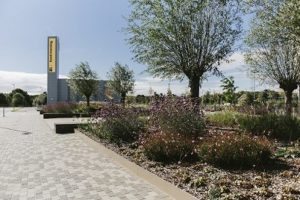Explore Our Campus
The University’s £330 million Waterside Campus was built with the following principles in mind:
- Open campus, for the community;
- Sensitive to its surroundings;
- Accessible, with cycle routes linking the town centre and Delapré Park;
- Designed to promote sustainable travel;
- Sustainable low carbon campus;
- Supporting a digitally transformed University.
Open campus, for the community and sensitive to its surroundings
Visitors to the campus note how the campus is sensitive to its surroundings with open parklands to the north (Beckets Park) and the south (Delapré Park). Visitors are encouraged to walk through the campus from either park or along New South Bridge Road and enjoy the significant investment the University made into the town including the landscaping which was a fundamental aspect of the construction of the Campus.
This includes the upgrading of the Memorial Garden which is located between the River Nene bridges on Nunn Mills Road and in the shadow of the Avon Cosmetic’s building. The area is split into a communal reflective area with a wide circle of benches facing onto a central area of planting. We also have situated benches for users to utilise in a more personal reflective manner, facing toward the river, on the raised area away from the planting.
The University buildings and facilities are open to members of the public to explore. The University has installed information boards at key locations around the site and members of the public are welcome to find out more about the history of the wider site. Members of the public may hire the sports pitches and we have supported various charities who have used the Campus for events and activities.
On our relocation from our two former sites, the University agreed to relocate its sculpture collection which had been gathered following kind donations to the University and its antecedent institutions.
Accessible, with cycle routes linking the town centre and Delapré Park
A key aspect of the masterplanning for the campus was the upgrading of a public right of way from Nunn Mills Road to Delapré Park which connects with footpaths extending to Brackmills and Hardingstone. This was significantly improved between the University campus and Ransome Road which provides walking and cycling routes through to Delapré Park. Dog walkers and runners also use the campus as part of their exercise routines.
Designed to promote sustainable travel
The Campus was designed with alternatives to private vehicles in mind. The main car parks are at the easterly and westerly ends of the campus and only bikes, buses and authorised vehicles may travel through the campus. The Campus is served by the extensive Stagecoach network of buses which crosses Northampton, serving the University’s Park and Ride site at Sixfields, the University’s halls of residence at Scholars’ Green, Northampton railway station and locations between these sites. The Campus is also part of the Northampton e-scooter geographic boundary which provides users with alternative methods of sustainable travel to and from the Campus.

Sustainable low carbon campus and supporting a digitally transformed University
Key to the low carbon principle is the University’s Energy Centre.
The system utilises wood chip to fuel the biomass boiler and gas for the boilers. This combination provides heating and hot water for all the buildings and student residencies on the site and saves over 1,000 tonnes of CO2 per year. Located at the end of University Drive and adjacent to the public right of way to Delapré Park, the Centre features a 1MW biomass boiler, three 4MW gas boilers and one 120m3 thermal storage vessel. All boiler stacks rise through a common 26m high tower.

Given the tower’s prominence, a 12m high LED screen and University signage has been incorporated into the cladding to create a landmark feature for the campus and the town. This screen can communicate a range of public and University messages and is a key aspect of the University’s digital screen network which extends through the campus buildings.